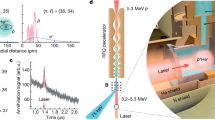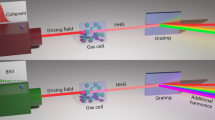Abstract
THE best light source for the spectroscopy of the extreme ultra-violet region is the hot spark. In the spectroscopic work at this Institute, the electrodes of the spark are usually connected through short straight leads to four condensers having a capacity C of 0.4 F. together. These are charged to a tension V = 5070 kv. The discharge through the spark is periodic with a period T of about 8 sec. (corresponding to a wave-length of 2,400 metres). The maximum current in the spark is If in our case, V = 50 kv., we have imax. = 16,000 amp. If we wish to increase the current in the spark we have to increase the tension V, which is possible only to a certain extent. Further, we can increase the capacity C, but this gives a rather slow increase in i. Finally, we can decrease the inductance in the circuit.
This is a preview of subscription content, access via your institution
Access options
Subscribe to this journal
Receive 51 print issues and online access
$199.00 per year
only $3.90 per issue
Buy this article
- Purchase on Springer Link
- Instant access to full article PDF
Prices may be subject to local taxes which are calculated during checkout
Similar content being viewed by others
References
M. Söderman, Diss., Uppsala, 1934.
Manne Siegbahn and M. Söderman, NATURE, 129, 21; 1932.
Author information
Authors and Affiliations
Rights and permissions
About this article
Cite this article
ALFVÉN, H., SANNER, V. Extension of the Ultra-Violet Wave-Length Limit. Nature 135, 580–581 (1935). https://doi.org/10.1038/135580b0
Issue Date:
DOI: https://doi.org/10.1038/135580b0
Comments
By submitting a comment you agree to abide by our Terms and Community Guidelines. If you find something abusive or that does not comply with our terms or guidelines please flag it as inappropriate.



